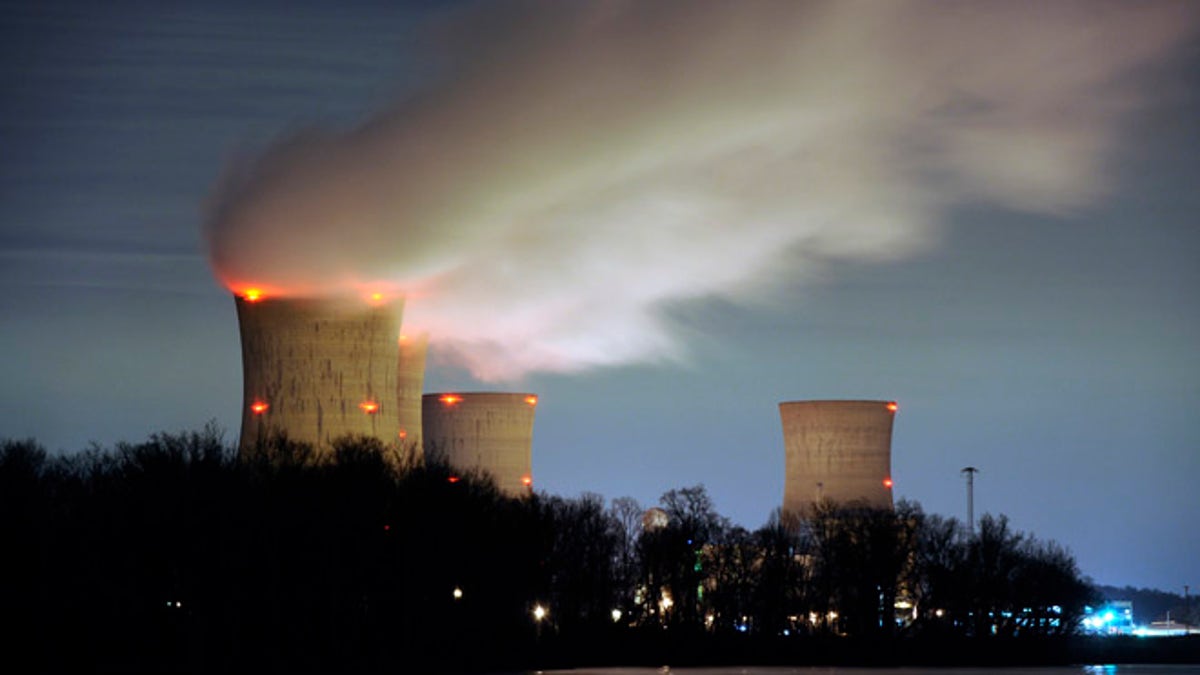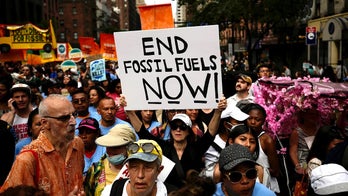
March 15, 2011: The Three Mile Island nuclear power plant, where the U.S. suffered its most serious nuclear accident in 1979, is seen across the Susquehanna River in Middletown, Pennsylvania in this night view. (Reuters)
As President Obama last month launched a sweeping new national program to combat "climate change," including tens of billions of dollars in likely new subsidies for solar and wind power and bio-energy, a separate, groundbreaking study by the National Research Council has warned that those kinds of subsidies are virtually useless at quelling greenhouse gases .
The study, which looks at the subsidies and other incentives embedded in U.S. federal tax law after the past several years of climate change initiatives, concludes that they have done little or nothing so far to cut U.S. contributions to global carbon emissions, and are unlikely to do much more before 2035, the project's research horizon.
The two-year, $2 million probe was the first of its kind undertaken to examine the relationship between U.S. tax provisions, a key tool of U.S. climate change policy, and the actual reduction of greenhouse gases.
The pioneering nature of the study itself speaks volumes about the murkiness of official knowledge concerning how well government can tweak the global thermostat by trying to radically reorient energy production and consumption in the U.S. economy.
It was carried out by a 12-member National Academy of Sciences panel of economists, energy experts, environmentalists, tax specialists and climate scientists backed by consultants wielding powerful computerized economic models and a sizeable handful of National Academy of Sciences staff.
After a survey of expert literature on the tax and subsidy topic, coupled with extensive customized computer modeling work, the study declared that "their combined impact is less than 1 percent of total U.S. emissions" over the next 25 years, and they are a lousy bargain to boot: "Very little if any GHG reductions are achieved at substantial cost with these provisions."
So much so, in fact, that the study concluded "current tax expenditures and subsidies are a poor tool for reducing greenhouse gases and achieving climate-change objectives." They "achieve small reductions in GHG emissions and are costly per unit of emissions reduction."
The full cost was something the study was unable to make entirely clear. It estimated that the federal government had spent some $48 billion in just the past two years on "tax expenditures"-meaning subsidies, credits, and other incentives -- related to the energy sector, and also noted that few were specifically enacted to reduce greenhouse gases.
(Using figures released by the Obama Administration, the Washington-based Institute for Energy Research (IER) has compiled a more specific figure for subsidies aimed at encouraging wind, solar and bio-fuels: $32 billion over the past four years. Even after that financial infusion, IER cites Department of Energy Information statistics that show combined wind and solar projects made up just 3.6 percent of U.S. electrical power generation capacity in 2012.)
A one-percent greenhouse gas reduction "doesn't get you very far," says William D., Nordhaus, a distinguished professor of economics at Yale University and chairman of the study committee.
Perhaps as importantly, the probe underlined how little is yet known about the relationship between government tax-and-spend activity and actual climate change results, especially as government spending gets embedded in a growing thicket of regulations and initiatives created to solve different parts of the greenhouse gas puzzle, but all touted to achieve the same ends.
Taking an attempt to overcome that lack of a comprehensive assessment of that tangle in climate change terms was a major aim of the study.
"The energy sector is full of complex regulations and taxes, and when you put them together, they act in counter-intuitive ways," Nordhaus told Fox News. "I was surprised by a number of them myself."
Among other things, Nordhaus pointed out, the study concludes that for some subsidies, notably for bio-fuels like ethanol, the net greenhouse effect has been negative. According to the study, "although it may seem obvious that subsidizing biofuels should reduce CO2 emissions because they rely on renewable resources rather than fossil fuels, many studies we reviewed found the opposite."
Instead, "tax credits for biofuels encouraged the consumption of motor fuels because they lower prices, and this effect appears to offset any reduction in the GHG intensity of motor fuels that occurs because of the incentives to blend biofuels with gasoline."
At the opposite end of the carbon suppression spectrum, the study found that subsidies that encourage drilling for oil and natural gas, especially depreciation allowances, have "virtually zero impact on emissions." In the case of natural gas - where immense discoveries through hydrological "fracking" are dramatically changing the U.S. energy profile -- "the complex substitution patterns among fuels lead to offsetting market forces and to a minimal impact on overall emissions."
Attacks on subsidies for oil and gas production have been a staple at the White House and among many environmental organizations.
The same ambiguities and complexities in the tax code make it likely to be even harder to predict the greenhouse gas results of additional billions in administration largesse -- past and future -- to encourage residential and office energy efficiency, as well as rural energy efficiency subsidies and other measures which figure large in the Administration's renewed climate change plans.
In looking at the biggest of these spending areas, residential energy efficiency subsidies (about $3.2 billion in 2010 alone), the NRC study declared that "the best existing analytical tools are unable to determine in a reliable fashion" what the beneficial greenhouse impact actually is.
So poor are the predictive tools, in fact, that the study committee warned against the formal tallying up - or "scoring," in Washington parlance - of the specific claimed impact of government tax actions on reductions in greenhouse gas emissions. "Much further work needs to be done before it can be accomplished routinely and reliably," the study concluded.
The administration was still willing to take at least a few stabs at that kind of accuracy in its 21-page, largely schematic climate plan. In the course of setting new energy efficiency standards, the plan says, the measures for "appliances and federal buildings set in the first and second [administration] terms combined will reduce carbon pollution by at least 3 billion metric tons cumulatively by 2030." It also claims that "first-ever" fuel economy standards for heavy-duty trucks, buses and vans, saying that once they go into effect in 2014 they will cut greenhouse bases by "approximately 270 million metric tons" over four years.
On the whole, however, the action plan focuses more on setting new targets for creating renewable power generation capacity, as well as taking credit for its old ones.
"In 2012 the President set a goal to issue permits for 10 gigawatts of renewables on public lands by the end of the year," the action plan says. "The Department of the Interior achieved this goal ahead of schedule and the President has directed it to permit an additional 10 gigawatts by 2020." By way of comparison, that is equivalent to 40 solar generating facilities each producing 250 megaways of power each.
(In fact, the Interior Department's ambitions are much bigger than that: all the permitting mentioned by Obama is part of a mammoth integrated solar development region sprawled across six south-western states, with significantly more capacity also available.)
According to the National Research Council report, government subsidies for such renewable generation facilities amount to "between $2 and 3 billion per year," which are linked to benefits currently of about 0.3 percent of U.S. power-sector emissions. Those benefits, however, "increase over time, the report states."
If anything, the president's plan calls for significantly more subsidies ahead.
The Defense Department is committing to deploy about 3 gigawatts of solar, wind, biomass and geothermal energy on military installations by 2025. Federal agencies intend to install 100 megawatts of additional renewable capacity in federally subsidized housing by 2020.
Among other things, the plan also calls for $7.9 billion in additional funding for advanced clean energy technology, a hike of about 30 percent. This includes investment in a range of energy technologies, from advanced biofuels to nuclear mini-reactors.
Overall, according to the plan, "the federal government will consume 20 percent of its electricity from renewable sources by 2020 - more than double the current goal of 7.5 percent."
CLICK HERE FOR THE ACTION PLAN
One certainty: anyone wishing to study further the efficiency and effectiveness of government subsidies - "tax expenditures" - for renewables will have plenty of fresh material to begin.
George Russell is editor-at-large of Fox News and can be found on Twitter @GeorgeRussell.
























